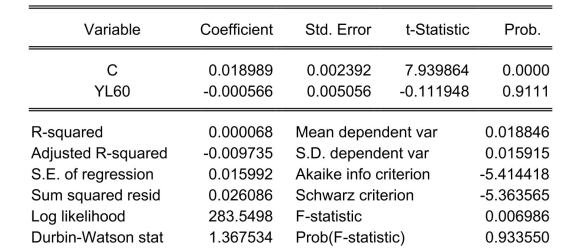The neoclassical growth model predicts that for identical savings rates and population growth rates, countries should converge to the per capita income level. This is referred to as the convergence hypothesis. One way to test for the presence of convergence is to compare the growth rates over time to the initial starting level, i.e., to run the regression , where is the average annual growth rate of GDP per worker for the 1960-1990 sample period, and is GDP per worker relative to the United States in 1960. Under the null hypothesis of no convergence, , implying ("beta") convergence. Using a standard regression package, you get the following output: Dependent Variable: G6090
Method: Least Squares
Date: 07/11/06 Time: 05:46
Sample: 1104
Included observations: 104
White Heteroskedasticity-Consistent Standard Errors & Covariance
You are delighted to see that this program has already calculated p-values for you.
However, a peer of yours points out that the correct p-value should be 0.4562.
Who is right?
Correct Answer:
Verified
Q38: Below you are asked to decide
Q39: (Continuation from Chapter 4, number 5)
Q40: (continuation with the Purchasing Power Parity
Q41: Changing the units of measurement obviously
Q42: (Requires Appendix material) Your textbook shows
Q43: In many of the cases discussed in
Q44: Your textbook discussed the regression model
Q46: (Requires Appedix material and Calculus) Equation
Q48: Consider the sample regression function
Q59: Your textbook states that under certain restrictive
Unlock this Answer For Free Now!
View this answer and more for free by performing one of the following actions

Scan the QR code to install the App and get 2 free unlocks

Unlock quizzes for free by uploading documents